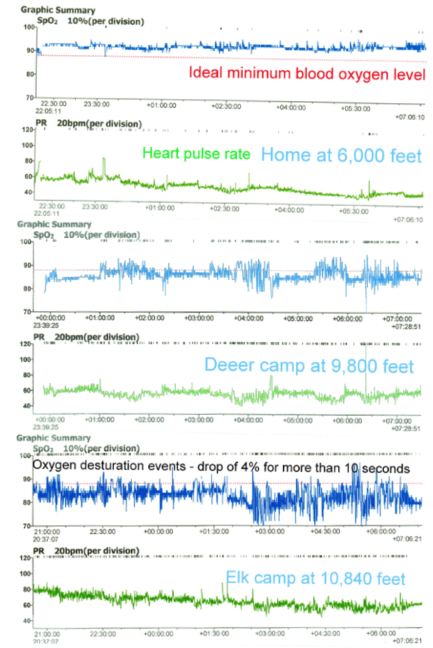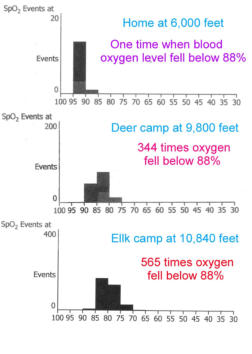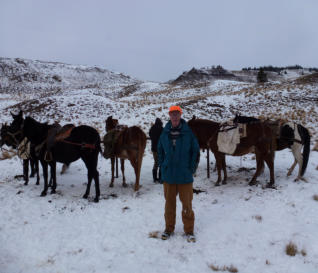


© 2014-2021 Copyright by P. K. H. Groth, Denver, Colorado, USA All rights reserved - See contact page for for permission to republish article
excerpts.
Testing Hunter Heart Stress
High Altitude Effects on Your Heart and Body
High Altitude Physical Exertion and Bad Sleeping Taxes the Heart and Mind: I have the typical
tangle of late-age health problems and the emergence of Post Polio Syndrome. I sure am not
complaining, because I enjoyed a magnificent sixty five years since my toddler polio
hospitalization. The upshot is that I studied my problems to solve them. I can now offer you the
information I collected to solve my problems as data proof for meeting high country hunting
health challenges.
Below are three tests of sleeping conditions during altitude acclimation. The graphs are of blood
oxygen saturations levels and the stress on the heart as evidenced by heart pulse rates. The
measurements were made using a pulse fingertip oximeter, which continually recorded data over
the night. A computer program analyzes the data and calculates the variations and abnormal, out-
of-bounds events. These events are: when blood oxygen drops at least 4% for a minimum of ten
seconds; when the heartbeat rate changes 6 beats per minute for a minimum of 8 seconds.
Now let us review the data. The dotted red line on the oxygen levels is the minimum 88% oxygen
saturation level which a healthy sleeper should have at Denver's mile high elevation. Keep in mind
this pertains to someone who lives in Denver and has acclimated to its mile high altitude.
Acclimation of someone from sea level takes from two weeks to months, depending on the
individual's age, health, breathing abilities (smoking emphysema, chest congestion) and physical
conditions such as overweight, poor vascular circulation, and diaphragm/chest intercostal muscle
tone limitations.
GRAPH 1 This data set was recorded on a typical night at my home at 6,000 feet west of Denver.
Here I use of a CPAP because I have sleep apnea. Notice that I maintained blood oxygen levels
above 88% except for one time. Look at the three black tick marks above the blue line. These are
times when I was above 88%, but my oxygen level varied by 4%. My blood oxygen concentration
was almost perfectly normal. The good oxygen levels allowed my physical body and most
importantly my mind to refresh itself. A constant good oxygen level allows deep REM sleep and
allows the brain/mind to rejuvenate
Study the green heart beat graph. Note how the heartbeat shows very little variation and how it
gradually decreases over the night and became even more stable. These data indicate I had a
good night's sleep with little stress on the heart. The deep sleep and low, non-erratic heartbeat
indicate the heart muscles and electrical synodes are not being stressed.
GRAPH 2 I took the oximeter to my 9,800 archery
deer hunting mountain camp. I drove to the
location five hours before I began the sleep test.
Note that most of the night I did not get enough
oxygen. The oxygen saturation levels continually
varied. Not until 5 AM did my breathing become
regulated enough to allow a stable (but low)
oxygen level. This permitted the heart to also
stabilize and I got about one hour of good sleep
and heart relaxation. Note the tick marks have
proliferated from one to 344 oxygen desaturation
events.
Graph 3 My elk camp is at 10,840 feet. I used to
back pack into the area. At 70, I started to use
outfitter Sherpa Service to get my camp in and
sometimes even ride a horse, which means I
arrive at camp relatively well rested. I arrive at
camp three days before opening morning to
acclimate. The test under the same conditions
began eleven hours after I arrived at camp and
acclimation had begun.
Note how going from 6,000 feet to 10,840 feet (an
added 1,000-foot elevation gain above deer camp)
has affected my blood oxygen levels. The blood
saturations are extremely variable and all are
below the minimum target 88%. Compare the
heart beat graph with the home graph #1. It is obvious that the heart is staining to meet the
pumping required to meet acceptable sleeping oxygen demands. Look at the pulse rate scale. The
at-rest, prone position heart beat thumps along at 80-70 BPM at 9 PM and does not drop to 60
BPM until 1:30 AM. Then it continues at about 50 BPM for most of the night, when at home the
beat leveld in the mid 40’s. This is stressful to the heart.
Oxygen Drop Event Histograms: At elk camp there were 565 times my blood oxygen level varies
more than 4% for a minimum of 8 seconds. Sometimes my blood oxygen saturation was only 70-
75%. My heart's sinus node was continually sending signals to pump more, pump less, pump
more. That is heart stress.
You can observe that physiological adjustment to high altitudes is
necessary for your health even when you are sleeping. Now
consider making daytime physical demands on your body and
heart by lifting weight, running to a kill, or even just the excitement
of seeing your prey. Do not ask for a medical disaster! Come to
altitude slowly by steps as prescribed by pulmonologists and
experienced mountain climbers (see book).
Poor Sleep May Cost You Hunting Success: Now in purple ink I
reiterate from my book. Until you are adjusted to altitude, you
simply will not be at full mental capacity. Deep, mind-
replenishing sleep will rarely be attained. You will make
misjudgments, mistakes, oversights, delays and irrational
quick conclusions. The elk and deer will have an advantage
over you. There is a good chance you might not even notice
your prey. If you lack mental acuity, you may have the split second delayed reaction of an
inebriated driver. You may miss your only shot at success and come home empty-handed.
Early morning rendezvous to pack in my elk camp - and eager anticipation of
another wonderful hunt!





3
2
1




- Hunter welfare
- Hunter poster child
- Altitude sickness
- Hunter heart attacks
- Hunter heart stress
- Altitude sleep problems
- Hunter spine/bone damage
- Back country hazards
- Man made hazards
- Hunter bear attacks
- Bear problems
- Mtn lion Awareness
- Insect problems and diseases
- Hunt camp rodent problems
- Game meat dangers
- Elk meat diseases



© 2016 -2021 Copyright by P. K. H. Groth, Denver, Colorado, USA All rights reserved -
See contact page for for permission to republish article excerpts.
Testing Hunter Heart Stress
High Altitude Effects on Your Heart and Body
High Altitude Physical Exertion and Bad Sleeping
Taxes the Heart and Mind: I have the typical tangle
of late-age health problems and the emergence of
Post Polio Syndrome. I sure am not complaining,
because I enjoyed a magnificent sixty five years
since my toddler polio hospitalization. The upshot is
that I studied my problems to solve them. I can now
offer you the information I collected to solve my
problems as data proof for meeting high country
hunting health challenges.
Below are three tests of sleeping conditions during
altitude acclimation. The graphs are of blood oxygen
saturations levels and the stress on the heart as
evidenced by heart pulse rates. The measurements
were made using a pulse fingertip oximeter, which
continually recorded data over the night. A
computer program analyzes the data and calculates
the variations and abnormal, out-of-bounds events.
These events are: when blood oxygen drops at least
4% for a minimum of ten seconds; when the
heartbeat rate changes 6 beats per minute for a
minimum of 8 seconds.
Now let us review the data. The dotted red line on
the oxygen levels is the minimum 88% oxygen
saturation level which a healthy sleeper should have
at Denver's mile high elevation. Keep in mind this
pertains to someone who lives in Denver and has
acclimated to its mile high altitude. Acclimation of
someone from sea level takes from two weeks to
months, depending on the individual's age, health,
breathing abilities (smoking emphysema, chest
congestion) and physical conditions such as
overweight, poor vascular circulation, and
diaphragm/chest intercostal muscle tone limitations.
GRAPH 1 This data set was recorded on a typical
night at my home at 6,000 feet west of Denver. Here
I use of a CPAP because I have sleep apnea. Notice
that I maintained blood oxygen levels above 88%
except for one time. Look at the three black tick
marks above the blue line. These are times when I
was above 88%, but my oxygen level varied by 4%.
My blood oxygen concentration was almost perfectly
normal. The good oxygen levels allowed my physical
body and most importantly my mind to refresh
itself. A constant good oxygen level allows deep REM
sleep and allows the brain/mind to rejuvenate
Study the green heart beat graph. Note how the
heartbeat shows very little variation and how it
gradually decreases over the night and became even
more stable. These data indicate I had a good night's
sleep with little stress on the heart. The deep sleep
and low, non-erratic heartbeat indicate the heart
muscles and electrical synodes are not being
stressed.
GRAPH 2 I took the oximeter to my 9,800 archery
deer hunting mountain camp. I drove to the location
five hours before I began the sleep test. Note that
most of the night I did not get enough oxygen. The
oxygen saturation levels continually varied. Not until
5 AM did my breathing become regulated enough to
allow a stable (but low) oxygen level. This permitted
the heart to also stabilize and I got about one hour
of good sleep and heart relaxation. Note the tick
marks have proliferated from one to 344 oxygen
desaturation events.
Graph 3 My elk camp is at 10,840 feet. I used to back
pack into the area. At 70, I started to use outfitter
Sherpa Service to get my camp in and sometimes
even ride a horse, which means I arrive at camp
relatively well rested. I arrive at camp three days
before opening morning to acclimate. The test under
the same conditions began eleven hours after I
arrived at camp and acclimation had begun.
Note how going from 6,000 feet to 10,840 feet (an
added 1,000-foot elevation gain above deer camp)
has affected my blood oxygen levels. The blood
saturations are extremely variable and all are
below the minimum target 88%. Compare the heart
beat graph with the home graph #1. It is obvious
that the heart is staining to meet the pumping
required to meet acceptable sleeping oxygen
demands. Look at the pulse rate scale. The at-rest,
prone position heart beat thumps along at 80-70
BPM at 9 PM and does not drop to 60 BPM until 1:30
AM. Then it continues at about 50 BPM for most of
the night, when at home the beat leveld in the mid
40’s. This is stressful to the heart.
Oxygen Drop Event Histograms: At elk camp there
were 565 times my blood oxygen level varies more
than 4% for a minimum of 8 seconds. Sometimes my
blood oxygen saturation was only 70-75%. My
heart's sinus node was continually sending signals to
pump more, pump less, pump more. That is heart
stress.
You can observe that
physiological
adjustment to high



3
2
1


- Hunter welfare
- Hunter poster child
- Altitude sicknesses
- Hunter heart attack
- Hunter heart stress
- Altitude sleep problems
- Hunter spine and bone injuries
- Back country hazards
- Man caused hazards
- Bear attacks
- Bear camp problems
- Mountain. lion awareness
- Insect diseases and problems
- Camp rodent problems
- Game meat dangers
- Elk diseases

























